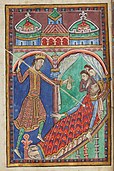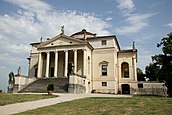Wikipedia:Today's featured article/August 2022
| << | Today's featured articles for August 2022 | >> | ||||
|---|---|---|---|---|---|---|
| Su | Mo | Tu | We | Th | Fr | Sa |
| 1 | 2 | 3 | 4 | 5 | 6 | |
| 7 | 8 | 9 | 10 | 11 | 12 | 13 |
| 14 | 15 | 16 | 17 | 18 | 19 | 20 |
| 21 | 22 | 23 | 24 | 25 | 26 | 27 |
| 28 | 29 | 30 | 31 | |||
August 1
Shannen Says is an eight-episode American reality television series broadcast on WE TV in 2012. The show focuses on the preparations for the wedding of actress Shannen Doherty (pictured) and photographer Kurt Iswarienko, with help from celebrity-wedding planner David Tutera. Filmed in Malibu, California, in 2011, Shannen Says was developed by Doherty and Iswarienko as a way to document the stress a couple experiences while planning their wedding. It was produced by RelativityReal and Doherty's production company No Apologies Productions. To prepare for filming, Doherty watched reality shows by Tori Spelling and Kim Kardashian. The series was released on the iTunes Store and Amazon Video, but it was not made available on DVD or Blu-ray. The show had low viewership and ranked below most other programs when it premiered, but it had some popularity among women between the ages of 25 and 54. Shannen Says and Doherty received mixed reviews. (Full article...)
August 2
El Camino: A Breaking Bad Movie is a 2019 American neo-Western crime thriller film that serves as a sequel and epilogue to the television series Breaking Bad. It continues the story of Jesse Pinkman, who partnered throughout the series with former teacher Walter White to build a crystal meth empire based in Albuquerque. Series creator Vince Gilligan wrote, directed, and produced the film; Aaron Paul (pictured) reprised his role as Jesse Pinkman. Gilligan started considering the story of El Camino while writing Breaking Bad's series finale. He approached Paul with the idea several years later, but told few others. After the script was complete and studio backing was obtained, principal photography discreetly began in New Mexico. In August 2019, Netflix released a trailer and unveiled the film's premiere date, surprising fans and critics alike due to the secrecy surrounding the project. The film drew positive reviews and won the Critics' Choice Award for Best Movie Made for Television. (Full article...)
August 3
The siege of Calais (4 September 1346 – 3 August 1347) marked the conclusion of the Crécy campaign, during the Edwardian phase of the Hundred Years' War. On 26 August 1346, an English army under King Edward III (effigy pictured) inflicted a heavy defeat on a large French army led by King Philip VI at the Battle of Crécy. A week later they invested the well-fortified port of Calais, which had a strong garrison under the command of Jean de Vienne. Edward made several unsuccessful attempts to breach the walls or to take the town by assault. During the winter and spring the French were able to run in supplies and reinforcements by sea, but in late April the English established a fortification which enabled them to command the entrance to the harbour and cut off the further flow of supplies. On 3 August Calais capitulated. The town provided the English with an important strategic lodgement, and was not recaptured by the French until 1558. (This article is part of a featured topic: Hundred Years' War, 1345–1347.)
August 4
The World Before the Flood is an oil-on-canvas painting by English artist William Etty, first exhibited in 1828. It depicts a scene from John Milton's Paradise Lost in which Adam sees a vision of the world immediately before the Great Flood. The painting illustrates the stages of courtship as described by Milton: a group of men select wives from a group of dancing women, take their chosen woman from the group, and settle down to married life. Behind them looms an oncoming storm, a symbol of the destruction which the dancers and lovers are about to bring upon themselves. When first exhibited at the 1828 Royal Academy Summer Exhibition, the painting attracted large crowds. Many critics praised it, but others condemned it as crude, tasteless and poorly executed. The painting, currently in the Southampton City Art Gallery, and a preliminary oil sketch for it, now in the York Art Gallery, were exhibited together in a major retrospective of Etty's work in 2011 and 2012. (Full article...)
August 5
Herman the Archdeacon (before 1040 – c. 1097) was a member of the household of Herfast, Bishop of East Anglia, in the 1070s and 1080s, and then a monk of Bury St Edmunds Abbey in Suffolk. He was probably born in Germany. Around 1070 he entered Herfast's household and assisted him in his unsuccessful campaign to move his bishopric to Bury St Edmunds Abbey. He remained with the bishop until the latter's death in 1084 and had moved to the abbey as a monk by 1092. Herman was a colourful character and a theatrical preacher, but he is chiefly known as an able scholar who wrote the Miracles of St Edmund (excerpt shown), a hagiographical account of miracles believed to have been posthumously performed by Edmund, King of East Anglia. Herman's account also covered the history of the eponymous abbey. Two revised versions of his Miracles were later written: a shortened anonymous work which cut out the historical information, and another by Goscelin, which was hostile to Herman. (Full article...)
August 6
"Dear Future Husband" is a song by Meghan Trainor (pictured), included on her 2014 extended play debut Title, and later on her 2015 studio album of the same name. Trainor wrote the song with its producer Kevin Kadish. Epic Records released "Dear Future Husband" as the album's third single on March 17, 2015. In it, she lists things a suitor needs to do to win her. Some music critics praised the song's playful nature, while others were negative about the portrayal of gender roles in its lyrics. In the U.S., the song reached number 14 on the Billboard Hot 100 and was certified 3× Platinum by the Recording Industry Association of America. Fatima Robinson directed the music video for "Dear Future Husband", which depicts Trainor baking pies in the kitchen and scrubbing the floor while various men audition to be her partner. It garnered controversy and online criticism over allegations of antifeminism and sexism. Trainor performed the song on television and included it on the set lists of her tours. (Full article...)
August 7
The springbok (Antidorcas marsupialis) is a medium-sized antelope found mainly in the dry areas of southern and southwestern Africa. A slender, long-legged bovid, it reaches 71 to 86 cm (28 to 34 in) at the shoulder and weighs between 27 and 42 kg (60 and 93 lb). Both sexes have a pair of long black horns that curve backwards, a white face, a dark stripe running from the eyes to the mouth, a light-brown coat with a reddish-brown stripe, and a white rump flap. Primarily browsing at dawn and dusk, it can live without drinking water for years, subsisting on succulent vegetation. Breeding peaks in the rainy season, when food is more abundant. A single calf is weaned at nearly six months of age and leaves its mother a few months later. Springbok herds in the Kalahari Desert and the semi-arid Karoo used to migrate in large numbers across the countryside. This antelope species is one of the few with an expanding population. The springbok is the national animal of South Africa. (Full article...)
August 8
American actor Billy Porter wore a black velvet tuxedo dress designed by Christian Siriano on the red carpet of the 91st Academy Awards (Oscars) on February 24, 2019. Porter had recently come into public view for his breakout role in the FX television series Pose, and his boundary-pushing red carpet attire during the 2018–19 film awards season. Following his appearance at the 76th Golden Globe Awards in a custom silver suit with fuchsia-lined cape, he was invited to host red carpet interviews at the Oscars pre-show. Porter approached Siriano and together they conceived the tuxedo gown. It was well-received by fashion journalists, who highlighted its elegant design and described it as a favorite Oscars dress and one of Porter's most fashionable red carpet looks. The gown cemented Porter's status as a celebrity and as a fashion icon. Porter considers the outfit a piece of political art intended to drive a conversation about men's fashion and masculinity. It has also received praise from academics and the general public, as well as criticism from conservative commentators. (Full article...)
August 9

Saint Vincent Beer was a dark lager brewed by monks at Saint Vincent Archabbey in Unity Township, Pennsylvania, between 1856 and 1918. It was brewed with the permission of Pope Pius IX after a dispute with the local diocese. The brewery was in a log cabin near the gristmill and supplemented by a brick building in 1868. Production peaked at around 1,100 barrels in 1891. Its popularity brought the monastery to the attention of the Catholic temperance movement. In 1895, Francesco Satolli, Apostolic Delegate to the United States, wrote to Archabbot Leander Schnerr asking for brewing to be stopped. A media campaign and criticism in Father George Zurcher's Monks and Their Decline led to the end of external sale by 1900, although the monks brewed for internal use for another 18 years. After the brewery was closed in 1918 by Archabbot Aurelius Stehle, the buildings were used for storage until they burned down in 1926. The recipe may have been lost, sold, or never written down. (Full article...)
August 10
The royal necropolis of Byblos is a group of nine Bronze Age underground shaft and chamber tombs housing the sarcophagi of several kings of the city. The site of Byblos (ruins pictured) was rediscovered in the late 19th century by French scholar Ernest Renan near modern Jbeil, Lebanon. Byblos traded with Egypt during the Bronze Age; this influence was shown in excavated reliefs bearing Egyptian hieroglyphs. In 1922, heavy rains triggered a landslide exposing an underground tomb containing a massive stone sarcophagus. The grave was explored by archaeologist Charles Virolleaud and Egyptologist Pierre Montet, who unearthed eight more tombs. The earliest tombs dated back to the 19th century BC; some were unspoiled, and contained royal gifts from pharaohs Amenemhat III and Amenemhat IV. The more recent graves, some from the Late Bronze Age, were robbed in antiquity. Seven stone sarcophagi were discovered, all undecorated except the Ahiram sarcophagus, famed for its Phoenician inscription. (Full article...)
August 11
C. J. Cregg is a fictional character, played by Allison Janney (pictured), on the American serial television drama The West Wing. From the beginning of the series in 1999 until the sixth season in 2004, she is White House press secretary in the administration of President Josiah Bartlet. After that, she serves as the president's chief of staff until the end of the show in 2006. The character is said to have been partially inspired by real-life White House press secretary Dee Dee Myers, who worked as a consultant on the show. Aaron Sorkin, the show's creator, designed Cregg to be assertive and independent from the show's men. She is portrayed as a smart, strong, witty, and thoughtful character, although she is frequently patronized and objectified by her male coworkers. Initially, she is portrayed as politically inept, but she quickly becomes one of the most savvy characters on the show. For her performance, Janney received four Primetime Emmy Awards and four Screen Actors Guild Awards. (Full article...)
August 12
Wipeout 2048 is a racing video game in which players pilot anti-gravity ships around futuristic race tracks. It was developed by SCE Studio Liverpool and published by Sony Computer Entertainment. A launch title for the PlayStation Vita hand-held console, the game was released on 19 January 2012 in Japan and on 22 February in Europe. It is the ninth instalment of the series Wipeout and the last game to be developed by Studio Liverpool. Wipeout 2048 is a prequel to the first game in the series. It was designed as a test-bed for the Vita. Studio Liverpool's suggestions of a touchscreen device and two separate analogue sticks were eventually incorporated into the console. Wipeout 2048 includes downloadable content and an online multiplayer mode, and allows cross-platform play with PlayStation 3 owners of Wipeout HD. Reviewers agreed that the game's graphics and visuals showcased the power of the Vita, but criticised its long loading times and other technical issues. (Full article...)
August 13
Palladian architecture is an architectural style based on the work of Andrea Palladio. Buildings which adhere to his concepts of symmetry, perspective and the principles of classical architecture are described as Palladian. This can be seen at Villa La Rotonda (pictured), one of Palladio's most influential designs, which he began around 1565. The style spread from Italy in the early 17th century and was introduced to England by Inigo Jones. The early 18th century saw a resurgence led by Richard Boyle, 3rd Earl of Burlington, whose own Chiswick House, and Holkham Hall with William Kent, are among the finest English Palladian buildings. In North America, Palladianism was taken up by Thomas Jefferson; his home, Monticello, was based on a design by Palladio. The style was superseded by Neoclassical architecture in the later 18th century, and in the 19th both were eclipsed by the Gothic Revival. Palladio remains an influential architect and works in his style continue to be built. (Full article...)
August 14
King's Highway 403 is a 400-series highway in Ontario, Canada, between Woodstock and Mississauga, which branches off southwards from Highway 401 and travels through Hamilton and Mississauga before reuniting with the 401. It is concurrent and co-signed with the Queen Elizabeth Way (QEW) for 22 km (14 mi) from Burlington to Oakville. The 403 designation was applied to a short stub in 1963; the entire route was completed when the Brantford to Ancaster section opened on August 15, 1997. The Woodstock to Burlington stretch was dedicated as the Alexander Graham Bell Parkway in 2016. Most of Highway 403 runs through suburbia, although the areas west of Hamilton are agricultural except for Brantford. In Hamilton, Highway 403 descends the Niagara Escarpment, then runs north of Hamilton Harbour to the QEW. It then travels through Burlington and Oakville, departing from the QEW to the north at the Mississauga–Oakville boundary. It then crosses Mississauga's city centre before turning north and ends at Highway 401. Some lanes continue north to Brampton as Highway 410. (Full article...)
August 15

Darjeeling is a town in India's Eastern Himalayas, situated close to the borders with Nepal, Bangladesh, Bhutan and China. In the mid-19th century, when much of India was under East India Company rule, Darjeeling was founded as a summer retreat. On the slopes below, tea plantations were laid out where Darjeeling tea is grown. Thousands of labourers from the surrounding regions built the town and worked in the tea plantations. Their descendants constitute the majority of Darjeeling's residents today and give the town a cosmopolitan ethnic mix. The Darjeeling Himalayan Railway, ascending 2,100 metres (7,000 ft), is a World Heritage Site and a popular tourist experience. The local economy is largely dependent on tourism and tea growing. Population growth has made unregulated construction, traffic congestion and water shortages common. Deforestation has damaged the environment, including the springs that supply the town's water. (Full article...)
August 16

The speed of light in vacuum, denoted c, is a physical constant that is exactly equal to 299,792,458 metres per second (approximately 186,282 miles per second, or one foot per nanosecond). According to standard modern physics, visible light and all other electromagnetic radiation moves at this constant speed in vacuum, and c is the fastest speed at which matter, energy or any signal carrying information can travel through space. Ole Rømer first demonstrated in 1676 that light does not travel instantaneously by studying the apparent motion of Jupiter's moon Io (diagram shown). In an 1865 paper, James Clerk Maxwell proposed that light was an electromagnetic wave, and therefore travelled at the speed c. According to the theory of special relativity, which interrelates space and time, all observers will measure the speed of light as being the same, regardless of the inertial reference frame of the observer or the velocity of the object emitting the light. (Full article...)
August 17
The Hill 303 massacre was a war crime that took place during the Korean War on August 17, 1950, on a hill above Waegwan, South Korea, when forty-one US Army soldiers held as prisoners of war were murdered. Troops of the North Korean People's Army (KPA) surrounded elements of the US 2nd Battalion, 5th Cavalry Regiment, 1st Cavalry Division, during the Battle of Pusan Perimeter. Most of the US troops escaped but one platoon misidentified KPA troops as South Korean reinforcements and was captured. US forces counterattacked and as the KPA began to retreat one of their officers ordered the prisoners to be shot so they would not slow them down. US commanders subsequently broadcast radio messages and dropped leaflets demanding that senior KPA commanders be held responsible. The KPA commanders, concerned about the way their soldiers were treating prisoners of war, laid out stricter guidelines for handling captives. Memorials were later constructed on Hill 303 to honor the victims of the massacre. (Full article...)
August 18
The Kharijites were an Islamic sect which emerged during the First Muslim Civil War (656–661). The first Kharijites emerged from the supporters of Caliph Ali while protesting against his peace talks with Mu'awiya at the Battle of Siffin in 657. After Ali defeated the Kharijites, he was assassinated in 661 by a vengeful Kharijite. As caliph, Mu'awiya kept them in check until the power vacuum caused by the Second Muslim Civil War allowed them to seize large areas in Persia and Arabia. Weakened by internal disputes, they were defeated by subsequent governments, although their revolts lingered on into the Abbasid period. Ibadis are the sole surviving sect. Rejecting noble descent as a requirement for the caliphal office, the Kharijites held that any pious Muslim could become caliph. Most Kharijite groups branded other Muslims as unbelievers. Mainstream Muslims have viewed the Kharijites as religious extremists, although some modern Arab historians have stressed their egalitarian tendencies. (Full article...)
August 19
Confirmation bias is a tendency for people to favor information that confirms their preconceptions. As a result, people recall information from memory selectively, and interpret it in a biased way, in particular for emotionally significant issues and established beliefs. Biased search, interpretation and recall have been invoked to explain attitude polarization (disagreeing parties diverging further when they are exposed to the same evidence), belief perseverance (beliefs persisting after the evidence for them is shown to be false), the primacy effect (data encountered early in a series being given more weight) and illusory correlation (people falsely perceiving an association between two events or situations). Explanations for these biases include wishful thinking and the limited human capacity to process information. Confirmation biases contribute to overconfidence in personal beliefs and can maintain or strengthen beliefs in the face of contrary evidence. This can lead to disastrous decisions, especially in organizational, military and political contexts. (Full article...)
August 20
Dr. No is the sixth novel by the English author Ian Fleming to feature his British Secret Service agent James Bond. Written at Fleming's Goldeneye estate in Jamaica, it was first published in the United Kingdom by Jonathan Cape in 1958. In the novel Bond looks into the disappearance in Jamaica of two fellow MI6 operatives who had been investigating Doctor No. Bond travels to No's Caribbean island and meets Honeychile Rider, who is there to collect shells. They are captured and taken to a luxurious facility carved into a mountain. The character of Doctor No, the son of a German missionary and a Chinese woman, was influenced by Sax Rohmer's Fu Manchu stories. Dr. No was the first of Fleming's novels to face widespread negative reviews in Britain, but it was received more favourably in the United States. The story was adapted in 1962 as the first film in the Bond series, with Sean Connery in the lead role. (This article is part of a featured topic: Ian Fleming's James Bond novels and short stories.)
August 21
The Battle of the Tenaru was a land battle between the Imperial Japanese Army and Allied forces on August 21, 1942, at Guadalcanal in the Solomon Islands during World War II. The U.S. Marines were defending the Lunga perimeter around Henderson Field, which had been captured by the Allies on August 7. The Japanese unit, commanded by Kiyonao Ichiki (pictured), was sent to recapture the airfield and drive the Allied forces off the island. Underestimating the strength of the Allied forces, Ichiki's unit conducted a nighttime frontal assault on Marine positions at Alligator Creek on the east side of the perimeter and were defeated with heavy losses. The Marines counterattacked after daybreak, and about 800 of Ichiki's original 917 men were killed. After Tenaru, the Japanese realized that Allied forces on Guadalcanal were much greater in number than originally estimated and sent larger forces for their later attempts to retake Henderson Field. (This article is part of a featured topic: Guadalcanal Campaign.)
August 22
Oscar Isaac (born 1979) is an American actor who is credited with contributing to a change in the portrayal of Latinos in Hollywood. Born in Guatemala, Isaac moved with his family to the United States while an infant. An alumnus of the Juilliard School, Isaac was a character actor in films for much of the 2000s. After gaining recognition for playing supporting parts in Robin Hood (2010) and Drive (2011), Isaac had his breakthrough with the eponymous role of a singer in the musical drama Inside Llewyn Davis (2013), which earned him a Golden Globe nomination. He became an international star with the role of Poe Dameron in the Star Wars sequel trilogy (2015–2019). Isaac was named the best actor of his generation by Vanity Fair in 2017 and one of the 25 greatest actors of the 21st century by The New York Times in 2020. His accolades include a Golden Globe Award, a National Board of Review Award and an appearance on Time's list of the 100 most influential people in the world in 2016. (Full article...)
August 23
Kaze to Ki no Uta ('The Poem of Wind and Trees') is a Japanese manga series written and illustrated by Keiko Takemiya. It was serialized in two shōjo manga (girls' manga) magazines: Shūkan Shōjo Comic from 1976 to 1980, and Petit Flower from 1981 to 1984. One of the earliest works in the shōnen-ai (male–male romance) genre, Kaze to Ki no Uta follows the tragic romance between two students at an all-boys boarding school in France during the late 19th century. The series was developed and published amid a significant transitional period for shōjo manga, as the medium shifted from an audience composed primarily of children to an audience of adolescents and young adults. It attracted controversy for its mature themes of sadomasochism, incest, and rape, but nevertheless achieved significant critical and commercial success, winning the 1979 Shogakukan Manga Award in the shōjo category. Kaze to Ki no Uta is regarded as a pioneering work of shōnen-ai, and is credited by critics with widely popularizing the genre. (Full article...)
August 24
The 1982 Embassy World Snooker Championship was a professional snooker tournament that took place between 30 April and 16 May 1982 at the Crucible Theatre, in Sheffield, England. It was the only event of the 1981–82 snooker season that carried world ranking points. Embassy, a British cigarette company, sponsored the tournament, and the World Professional Billiards and Snooker Association governed the organisation of the event. It had a prize fund of £110,000, with the winner receiving £25,000. The defending champion, Steve Davis (pictured), had defeated Doug Mountjoy with a score of 18–12 in the previous year's final. In 1982, Davis was the bookmaker's favourite to win the tournament, but he lost 1–10 to Tony Knowles in the first round. Alex Higgins won his second world title by defeating Ray Reardon 18–15 in the final. Ten century breaks were made during the tournament, the highest of which was a 143 scored by Willie Thorne. (Full article...)
August 25
Zufar ibn al-Harith al-Kilabi (died c. 695) was a Muslim commander from the Arab tribe of Banu Amir, and the leader of the Qays faction in the late 7th century. During the First Muslim Civil War he led his tribe in A'isha's army against Caliph Ali at the Battle of the Camel in 656. In 657 he fought under Mu'awiya against Ali at the Battle of Siffin. During the Second Muslim Civil War he served Caliph Yazid I against anti-Umayyad rebels in the Battle of al-Harra in 683. After Yazid died, Zufar supported Abd Allah ibn al-Zubayr's bid against the Umayyads. At the Battle of Marj Rahit in 684, the Qays were crushed by the Umayyads and their allies. Zufar then set up headquarters in Qarqisiya and led the Qays tribes against the Kalb. After three sieges of Qarqisiya from 685 to 691, Zufar negotiated a peace with Caliph Abd al-Malik. Zufar's troops were pardoned, rewarded and integrated into the Umayyad military. The peace was sealed by the marriage of Zufar's daughter Rabab to the caliph's son Maslama. (Full article...)
August 26

The Old Head coinage were British coins struck and dated between 1893 and 1901, with a portrait by Thomas Brock of an aged Queen Victoria (example shown). It replaced the Jubilee coinage, struck since 1887, which had been widely criticised. In 1891, a committee was appointed to consider the matter, and recommended replacements. Some coins continued with their old reverse designs, with Benedetto Pistrucci's design for the sovereign extended to the half sovereign, and others gained new ones, created either by Brock or by Edward Poynter. The issue became the first to bear, as part of the monarch's royal titles, IND IMP, abbreviated Latin for 'Empress of India'. The issue originally consisted only of gold and silver coins, but in 1895, the Brock head of Victoria was placed on the bronze coinage (the penny and its fractions) as well. They continued to be struck until Victoria's death in 1901 caused a change in the obverse design; starting in 1902, the coinage bore the head of her successor, Edward VII. (Full article...)
August 27
Kelenken is a genus of phorusrhacid, an extinct group of large, predatory birds, which lived in what is now Argentina about 15 million years ago. The only known specimen was discovered by high school student Guillermo Aguirre-Zabala in Patagonia, and was made the holotype of the new genus and species Kelenken guillermoi in 2007. The generic name references a spirit in Tehuelche mythology, and the specific name honors its discoverer. The holotype consists of a nearly complete skull, a lower leg bone and a toe bone. The discovery of Kelenken clarified the anatomy of large phorusrhacids: flightless birds with long hind limbs, small wings, huge skulls and hooked beaks. At 716 mm (28.2 in) long, the skull of Kelenken is the largest known of any bird. Kelenken is thought to have been about 3 m (10 ft) tall and exceeded 100 kg (220 lb) in weight. It differs from its relatives in its larger size, length of its beak and details of its skull. It is thought to have been a fast-running ground predator. (Full article...)
August 28
SS Edward L. Ryerson is a steel-hulled American Great Lakes freighter which entered service in 1960. Built between 1959 and 1960 for the Inland Steel Company, she was a member of the so-called 730-class of lake freighters, which shared the unofficial title of "Queen of the Lakes" due to their record-breaking length of 730 feet (222.5 m). The last steam-powered freighter built on the lakes, she began her maiden voyage on August 4, 1960, heading from Escanaba, Michigan, for Indiana Harbor, Indiana, with a cargo of iron ore. Edward L. Ryerson quickly became popular, to the point that there were rumors she would regularly be directed through the lock closest to the shore, the MacArthur Lock, for the benefit of boat watchers. She set two Great Lakes cargo haulage records during the 1960s, with the latter, set on August 28, 1962, being broken in 1965. Edward L. Ryerson has been laid up in Superior, Wisconsin, since 2009. (Full article...)
August 29
A filibuster lasting 24 hours and 18 minutes was conducted on August 28–29, 1957, by Democratic U.S. senator Strom Thurmond (pictured), intended to prevent the passage of the Civil Rights Act of 1957. He read the election laws of each U.S. state, Supreme Court decisions, and George Washington's Farewell Address. The bill's power to protect the voting rights of African Americans had already been significantly watered down by Senate Democrats, but Thurmond saw the bill as "cruel and unusual punishment" and felt more intervention was needed. In filibustering the bill, Thurmond went against a prior agreement among Senate Democrats and therefore received backlash from some members of his own party in addition to the disapproval of Republicans. Despite this, the filibuster was wildly popular among citizens of the South. The filibuster ultimately failed to change any votes in the Senate and the bill was signed into law by President Dwight D. Eisenhower less than two weeks later. (Full article...)
August 30
Judith Resnik (1949–1986) was an American electrical, software and biomedical engineer, pilot and astronaut who died in the Space Shuttle Challenger disaster in January 1986. Resnik was the fourth woman and second American woman to fly in space, logging 145 hours in orbit. With a PhD in electrical engineering, she worked for RCA as an engineer on Navy missile and radar projects, and for Xerox as a senior systems engineer. She published research on special-purpose integrated circuitry. At age 28, she was selected by NASA as a mission specialist in the first NASA astronaut group to include women. While training she developed software and operating procedures for NASA missions. Her first space flight was the STS-41-D mission, the maiden voyage of Space Shuttle Discovery which launched on August 30, 1984, during which her duties included operating the orbiter's robotic arm. Her second shuttle mission was STS-51-L aboard Challenger. She died when it broke up shortly after liftoff. (Full article...)
August 31
Carlton Town Football Club is a semi-professional football club based in Gedling, Nottinghamshire, England. Founded in 1904 as Sneinton Football Club, it was described in 1909 as "the leading amateur football club in Nottingham". Its reputation declined thereafter, with the team participating in obscure county divisions until the 1995–96 season saw the club join the nationwide league system. Carlton competes in the Northern Premier League's Division One East in the eighth tier of the English football pyramid. Its home base since the early 1990s has been the Bill Stokeld Stadium (entrance pictured). It won promotion in 2006–07 from the Premier Division of the Northern Counties East Football League. Tournament records include reaching the third round of the FA Amateur Cup four times; the third qualifying round of the FA Cup twice; the first round of the FA Trophy in 2021–22; and the third round of the FA Vase in 2005–06. The club is nicknamed "the Millers" and its main colours are yellow and blue. (Full article...)





















